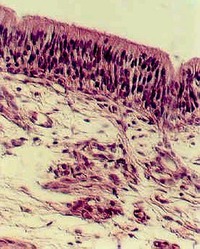The differential staining of this section shows the amount and distribution of elastic and collagenous fibers, smooth muscle, basement membranes, epithelium, cartilage, blood vessels, pleura, alveolar macrophages and capillary walls. The alveoli are collapsed in many regions. So, this slide is best for the bronchi and associated structures. Look at the Pleural covering which shows a red-colored mesothelial lining. This is supported by connective tissue containing abundant collagen fibers stained green.

Bronchial epithelium is ciliated, respiratory epithelium with Goblet cells. The epithelium rests on a purple-stained Basement Membrane.
Find the smooth muscle in the wall of the bronchus. The fibers are arranged circularly and stained pink. Prominent features of the bronchial wall are the cartilaginous bars and plates. You can also see Bronchial vessels and nerve fiber bundles. Bronchi are accompanied by branches of the Pulmonary arteries. Note that the arteries and veins contain a considerable amount of elastic fibers.

Look at the epithelium under a higher power. The pseudostratified characteristic continues. Also, you may see Goblet cells. Note the thick purple stained basement membrane under which is a layer of black-stained, mostly longitudinally arranged elastic fibers.
Bronchioles
The lung includes Terminal Bronchioles, Respiratory Bronchioles, Alveolar Ducts, Alveolar Sacs and Alveoli. Find each of these structures on your slide 46, using the following photos as a guide.

The larger bronchioles are lined with an epithelium that is pseudostratified columnar with or without cilia. However, the Goblet cells are no longer present. Also, there are no more cartilage plates. As the bronchioles become smaller, the epithelium becomes cuboidal.
Most bronchioles show a pronounced smooth muscle coat. In this slide, the smooth muscle is red, embedded in green connective tissue. The bronchioles are also accompanied by pulmonary arteries, seen in the photograph to the left. Note that the bronchiole is easily distinguished from the thin walled alveoli.
As you study these sections, you can appreciate the extent of the capillary bed in the lung. All blood vessels are filled with red blood cells, which delineate the capillary spaces. Occasional blood cells have spilled out....this is a fixation or postmortem artifact.

This photograph shows a higher magnification of the wall of a bronchiole. You can see the capillaries as well as the smooth muscle in the wall. This is a small bronchiole because its epithelium is more cuboidal.

A higher magnification of a bronchiole wall shows the ciliated cuboidal epithelial cells. There are also some non-ciliated rounded secretory cells called Clara Cells. These are distinguished by their smooth rounded apical "domes" which project into the bronchiolar lumen. Note again the smooth muscle in the wall of the bronchiole. What is the function of the Clara cell?

Find both terminal bronchioles and respiratory bronchioles in this section. Recall that respiratory bronchioles have outpocketings of alveoli in the wall (hence their name). Terminal bronchioles, such as the one shown in the photograph to the left, end and connect with the walls of alveoli. In this photograph, the alveoli are arranged in a long duct and then they expand to form an alveolar sac. Find the same structures on your slide.

A higher magnification of a terminal bronchiole shows the transition between the bronchiolar wall and the alveolar walls.
Alveolus

Look at the wall of alveoli. The Type I alveolar cells are the extremely thin (0.2 microns) squamous cells. Sometimes, only their nuclei are visible with the light microscope.
Another type of alveolar cell is the Type II cell. These are characterized by a reddish, foamy or vacuolated cytoplasm. Usually they are located at the angular junctions of alveolar walls.

Two more Type II cells are shown in the photograph to the left. The photograph beneath it shows more examples of the alveolar wall. What is the function of the Type II Alveolar cells?

Look at Slide 47. In this slide you should be able to see small Bronchi. You can also see bronchioles which are distinguished by the absence of cartilage plates. Identify terminal and respiratory bronchioles, alveolar ducts and alveolar sacs. Throughout the section, you may see particle-laden alveolar macrophages (shown in the following photograph).

Why do the ciliated cells extend further down the bronchiolar tree than the Goblet cells?
As you study the respiratory system, draw the cellular and connective tissue layers which separate blood from the air spaces. Also, be able to trace the blood supply to and from the lung and heart.
http://microanatomy.net/respiratory/lung.htm
Gwen V. Childs, Ph.D., FAAA
Department of Neurobiology and Developmental Sciences
University of Arkansas for Medical Sciences
4301 W. Markham, Slot 510, Little Rock, AR 72205
For questions or concerns, send email to this address



